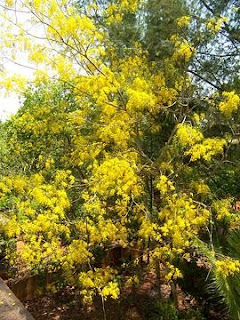Role of Golden Shower Tree in skin diseases

In Ayurvedic medicine, Golden Shower Tree is known as aragvadha ("disease killer"). Its fruitpulp is used as mild laxative, against fevers, arthritis, vatavyadhi (nervous system diseases), all kinds of rakta-pitta (bleeding, such as hematemesis or hemorrhages), as well as cardiac conditions and stomach problems such as acid reflux. The root is considered a very strong purgative. According to Hartwell (1967-1971), the plants are used in folk remedies for tumors of the abdomen, glands, liver, stomach, and throat, cancer, carcinomata, and impostumes of the uterus. Reported to be aperient, astringent, laxative, purgative, and vermifuge, Indian laburnum is a folk remedy for burns, cancer, constipation, convulsions, delirium, diarrhea, dysuria, epilepsy, gravel, hematuria, pimples, and glandular tumors (Duke and Wain, 1981). Ayurvedic medicine recognizes the seed as antibilious, aperitif, carminative, and laxative, the root for adenopathy, burning sensations, leprosy, skin diseases, syphilis, and tubercular glands, the leaves for erysipelas, malaria, rheumatism, and ulcers, the buds for biliousness, constipation, fever, leprosy, and skin disease, the fruit for abdominal pain, constipation, fever, heart disease, and leprosy. Yunani use the leaves for inflammation, the flowers for a purgative, the fruit as antiinflammatory, antipyretic, abortifacient, demulcent, purgative, refrigerant, good for chest complaints, eye ailments, flu, heart and liver ailments, and rheumatism, though suspected of inducing asthma. Seeds are considered emetic. Konkanese use the juice to alleviate ringworm and blisters caused by the marking nut, a relative of poison ivy. Leaf poultices are applied to the chilblains so common in the upper Sind; also used in facial massage for brain afflictions, and applied exter- nally for paralysis and rheumatism, also for gout. Rhodesians use the pulp for anthrax, blood poisoning, blackwater fever, dysentery, and malaria. Gold Coast natives use the pulp from around the seed as a "safe and useful purgative" (Kirtikar and Basu, 1975). Throughout the Far East, the uncooked pulp of the pods is a popular remedy for constipation, thought to be good for the kidneys "as those who use it much remain free of kidney stones" [Heyne as cited in Perry (1980)]. A decoction of the root bark is recommended for cleansing wounds. In the West Indies, the pulp and/or leaves are poulticed onto inflamed viscera, e.g. the liver. The bark and leaves are used for skin diseases: flowers used for fever, root as a diuretic, febrifuge; for gout and rheumatism. Now leaf of aaragvadh is used as anti-fungal in many of skin diseases. Its external application with dahi show dramatic improvement in skin diseases.


Comments